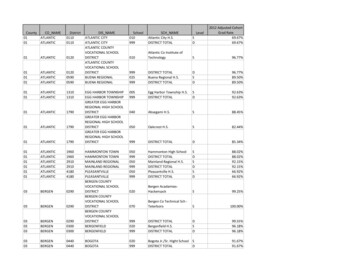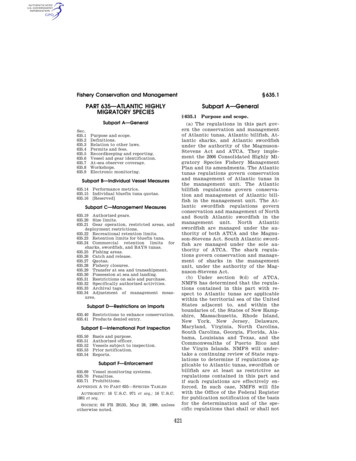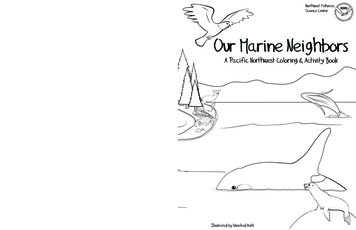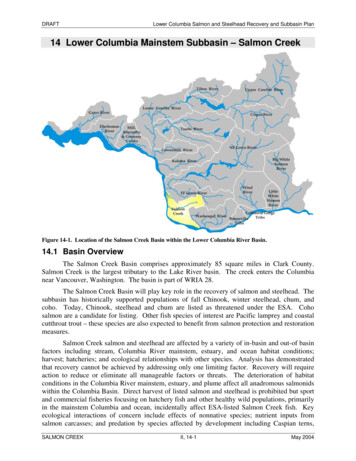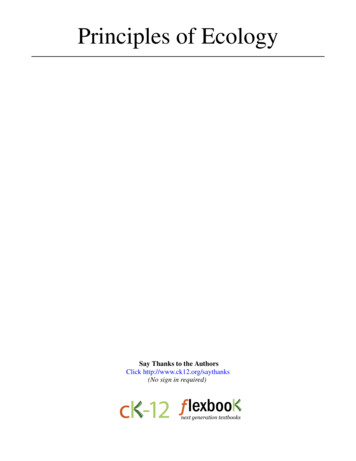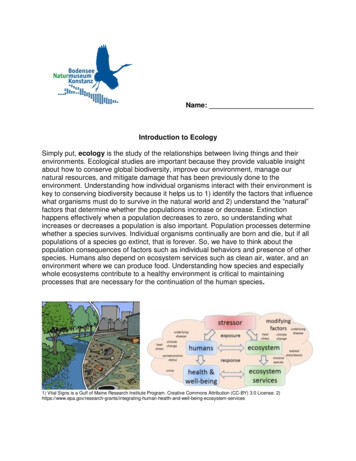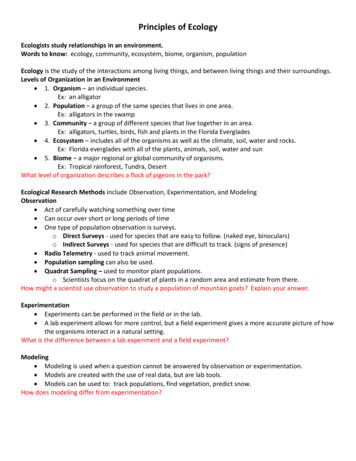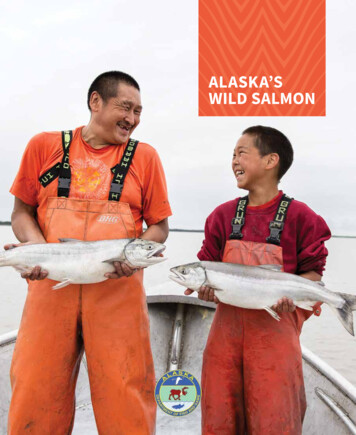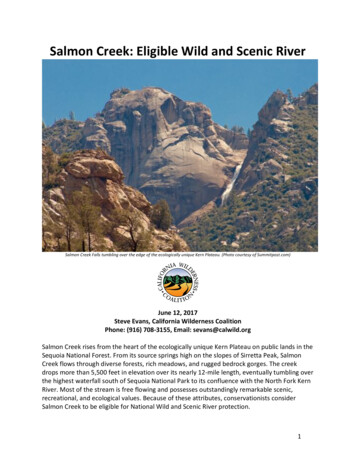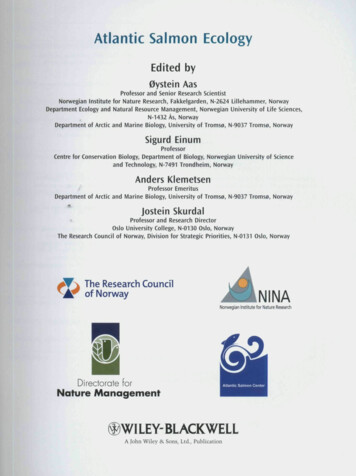
Transcription
Atlantic Salmon EcologyEdited by0ystein AasProfessor and Senior Research ScientistNorwegian Institute for Nature Research, Fakkelgarden, N-2624 Lillehammer, NorwayDepartment Ecology and Natural Resource Management, Norwegian University of Life Sciences,N-1432 As, NorwayDepartment of Arctic and Marine Biology, University of Tromse, N-9037 Troms0, NorwaySigurd EinumProfessorCentre for Conservation Biology, Department of Biology, Norwegian University of Scienceand Technology, N-7491 Trondheim, NorwayAnders KlemetsenProfessor EmeritusDepartment of Arctic and Marine Biology, University of Tromso, N-9037 Tromso, NorwaymJostein SkurdalProfessor and Research DirectorOslo University College, N-0130 Oslo, NorwayThe Research Council of Norway, Division for Strategic Priorities, N-0131 Oslo, NorwayThe Research Councilof NorwayAM I MIMANorwegian Institute for Nature ResearchDirectorate forNature ManagementWILEY-BLACKWELLA John Wiley & Sons, Ltd., Publication
ContentsForewordPreface and acknowledgementsReviewersContributorsGlossary1 Aquatic Nomads: The Life and Migrations of the Atlantic SalmonEva ff. Thorstad, Fred Whoriskey, Audun H. Rikardsen & Kim Aarestrup1.11.21.31.4IntroductionAtlantic salmon life cycleGeographic distributionSmolt and post-smolt migration - from juvenile life in the riverto feeding in the ocean1.4.1Downriver smolt migration1.4.2Marine post-smolt migration1.5Spawning migration - from feeding in the ocean to spawningin the river1.5.1Returning from ocean feeding grounds and enteringthe rivers1.5.2Upstream river migration1.5.3Factors affecting the upstream river migration1.6Kelt migration - after spawning and during outward migration1.7Homing and orientation mechanisms1.8Conclusion and future research needsReferences2 Reproductive Ecology: A Tale of Two SexesIan A. Fleming & Sigurd Einum2.12.2IntroductionReproductive strategies: age and size at maturity2.2.1 Among populations2.2.2 Within populations and the evolution of alternativereproductive phenotypes2.2.3 Anadromous and resident 23333335353740
Contents2.3Reproductive investment2.3.1 Differences between the sexes2.3.2Differences between reproductive phenotypes2.3.3Survival costs2.4Breeding behaviour and success2.4.1 Females2.4.2 Anadromous males2.4.3Mature male parr2.5Reproductive success through effects on the next generation2.5.1 Egg and larvae development2.6Maternal influences on offspring2.6.1 Egg size2.6.2Spawning time2.6.3Spawning location and consequences for populationproductivityReferences3 Freshwater, Habitat Requirements of Atlantic SalmonAnders G. Finstad, John D. Armstrong & Keith H. Nislow3.13.2IntroductionThe fundamental niche and freshwater habitat requirements3*.2.1 Scope for growth3.2.2Trading off growth and survival3.3Realised niche and observed habitat use3.4Large-scale determinants of Atlantic salmon habitat3.5Managing Atlantic salmon freshwater habitats3.5.1 General principles3.5.2Optimum habitat-production landscapes3.5.3Management strategies3.5.4Reference conditions and habitat management3.5.5The futureReferences4 The When, What and Where of Freshwater FeedingMorten Johansen, Jaakko Erkinaro & Per-Arne Amundsen4.14.24.34.44.5IntroductionDiet selectivityDrift vs. benthic feedingOntogenetic changes in diet4.4.1 Fry4.4.2 Parr4.4.3 Smolt4.4.4 AdultsTemporal feeding patterns4.5.1 Day vs. night4.5.2 787880818282838990909698999999100100101101
Contents4.6Spatial feeding patterns4.6.1 Microhabitat scale4.6.2 Mesohabitat scale4.6.3 Habitat scale4.7Interspecific food resource partitioning4.8Concluding remarks and future perspectivesReferences5 Dietary Life-Support: The Food and Feeding of Atlantic Salmon at SeaAudun H. Rikardsen & ]. Brian Dempson5.15.2IntroductionPost-smolt nearshore feeding5.2.1 Geographical and annual differences5.3Open ocean feeding of post-smolts5.3.1 Post-smolt diet in the open ocean5.4Open ocean feeding of pre-adults and adult pre-spawningsalmon5. .1 Northwest Atlantic Ocean5.4.2 Northeast Atlantic Ocean5.5 .«Summary and conclusionsAcknowledgementsReferences6 The Behavioural Flexibility of Salmon GrowthTorbj0rn Forseth, Benjamin H. Letcher & Morten Johansen6.16.26.3IntroductionPatterns of Atlantic salmon growthEnvironmental sources of growth variation6.3.1 Abiotic factors6.3.2 Biotic factors6.4Maternal sources of growth variation6.5Genetic sources of growth variation6.6Constraints to growth6.7Growth modelling6.7.1 Laboratory models6.7.2 Field-based models6.8Perspectives for managementReferences7 The Role of Competition in the Ecology of Juvenile Atlantic SalmonKeith H. Nislow, John D. Armstrong & James W. A. Grant7.17.2IntroductionIntraspecific competition7.2.1 Intracohort interactions7.2.2 Intercohort competition7.2.3 Competition among wild and farmed Atlantic 61161171171172173178182
Contents7.3Interspecific competition7.3.1. Species assemblages in Atlantic salmon rivers7.3.2Competitors other than fish7.3.3Non-salmonid fishes as competitors7.3.4Competition with other salmonid 90Predation: Compensation and Context DependenceDarren M. Ward & Nils A. 209212213213214215215IntroductionMajor salmon 5' Post-smolts in estuaries8.2.6Post-smolts at sea3,2.7 Adults8.3Conceptual models of predation8:-3.1 Additive and compensatory mortality8.3.2Functional response8.3.3Predator abundance8.3.4Trait-mediated effects8.3.5Implications of predation for salmon populations8.3.6Predator control8.4ConclusionsReferences9The Parasites and Pathogens of the Atlantic Salmon: Lessons fromGyrodactylus Solaris221Phil D. Harris, Lutz Bachmann & Tor A. Bakke9.19.2IntroductionThe parasite community of Atlantic salmon9.2.1The parasite community of freshwater immature stages9.2.2The parasite community of salmon in the sea9.2.3The parasite community in adult fish returning tofresh water9.36. salaris and the epidemiological triangle9.3.1G. salaris: 'The Russian doll killer'9.3.2The agent: pathogenic or benign? Taxonomic issuessurrounding G. salaris9.3.3The physicochemical environment: The role of environmentin shaping infection outcomes9.4Managing disease in wild salmonid 1244
Contents10 The Effect of Sea Lice on Atlantic Salmon and other Salmonid SpeciesBengt Finstad, Pal A. Bjarn, Christopher D. Todd, Fred Whoriskey,Patrick G. Gargan, Gregory Forde & Crawford W. Revie10.1Introduction10.1.1 Sea lice biology10.1.2 General effects of sea lice on fish physiology10.1.3 General effects of sea lice on fish populations10.2 The sea lice story from Norway10.2.1 Historical data10.2.2 Infestation levels of Atlantic salmon post-smolts10.2.3 Sea lice effects on Atlantic salmon - adult returns10.3 The sea lice story from Canada10.3.1 Historical data10.3.2 Effects of sea lice on Atlantic salmon - east coast10.3.3 Effects of sea lice on salmonids - west coast10.4 The sea lice story from Ireland10.4.1 Effects of sea lice on Atlantic salmon10.4.2 Effects of sea lice on sea trout10.5 The sea lice story from Scotland 0.5.1 Historical data10.5.2 Effects of sea lice on Atlantic salmon10.6 Management10.6.1 Sea lice management in Norway10.6.2 Sea lice management in Canada10.6.3 Sea lice management in Ireland10.6.4 Sea lice management in Scotland10.7 Concluding remarksReferences11 Variation in Population Size through Time and Space:Theory and Recent Empirical Advances from Atlantic SalmonSigurd Einum & Keith H. Nislow11.111.2IntroductionTemporal variation in Atlantic salmon abundance11.2.1 Density dependence vs. density independence11.2.2 Empirical evidence for density dependence in Atlanticsalmon11.3 Environmental influences on population dynamics11.4 Density dependence throughout the juvenile stage11.5 Spatial aspects of density dependenceReferences12 Stock, Recruitment and ExploitationKjetil Hindar, Jeffrey A. Hutchings, Ola H. Diserud & Peder Fiske12.112.2IntroductionState of Atlantic salmon populations12.2.1 Migratory populations12.2.2 Non-migratory 0284286288291295299299302303306
Contents12.3Stock and recruitment in Atlantic salmon populations12.3.1 Spatial variation in stock and recruitment relationships12.3.2 Temporal variation in SR relationships12.4 Spawning targets: from single populations to nation-wide levels12.4.1 Methodology - transfer from data-rich to data-poor rivers12.4.2 Spawning targets for North America12.4.3 Spawning targets for Europe12 A A Spawning target uncertainties12.5 Exploitation12.5.1 History of exploitation12.5;2 Exploitation rates12.5.3 Composition of catches12.6 Evolutionary and ecological effects offishing12.7 Management implicationsReferences13 Landscape and Land Use Effects on Atlantic SalmonOla Ugedal & Anders G. Finstad13.113.2IntroductionT*he multiple spatial scales of freshwater productivity13.2.1 Global and regional scales13.2.2 Catchment and reach scales13.3 Land use and Atlantic salmon13.3.1 Global trends13.3.2 Catchment effects13.4 Concluding remarksReferences14 Hydropower Development - Ecological EffectsBjorn Ove Johnsen, Jo Vegar Arnekleiv, Lars Asplin, Bjorn T. Barlaup,Tor F. Naisje, Bjern Olav Rosseland, Svein Jakob Saltveit & Arve Tvede14.114.2IntroductionChanges in physical, chemical, hydrological and biologicalfactors in rivers and fjord systems as a consequence ofhydropower development14.2.1 River systems14.2.2 Fjord systems14.3 Changes in survival, growth, migration and production ofsalmon in rivers and fjords14.3.1 Rivers14.3.2 Fjord systems14.4 Measures to compensate for negative effects of hydropowerdevelopment14.4.1 Use of biological and physical measures14.5 2356356360362362367368369374376
Contents15 Lessons from Acidification and PesticidesBjorn Olav Rosseland & Frode Kroglund15.1 General water quality of Atlantic salmon rivers15.2 Major classes of pollutants15.3 Acidification15.4 Pesticides and Atlantic salmon15.5 ConclusionReferences16 Getting into Hot Water? Atlantic Salmon Responses to Climate Change inFreshwater and Marine EnvironmentsChristopher D. Todd, Kevin D. Friedland, Julian C. MacLean, Neil Hazon& Arne J. Past and present climate for Atlantic salmonUpstream river migration and spawningEggs and alevinsPar/lifeSmolt migrationGeographical distribution and recent trends in adult stock abundanceOcean climate influences on run-timing and adultabundance/recruitment16.9 Migration, diurnal behaviour and changes in the epipelagic food web16.10 Do changes in North Atlantic zooplankton communities compriseregime shifts?16.11 Change in size and growth in the marine environment16.12 Adult somatic condition and lipid reserves: indicators of ocean climatedeterioration?16.13 Maturity schedules16.14 Large-scale indicator indices of ocean climate change and impactson salmon16.15 Management issues and responses to changes in ocean climateReferences17 Salmon Ecological Research and Conservation0ystein Aas, David Policansky, Sigurd Einum & Jostein 1942142342442542642742843143244517.1 Introduction17.2 Ecological research that contributes to conservation17.3 Environment, genetics, and changes in life-history17.4 Enhanced cooperation17.5 Multidisciplinary scienceReferences445448451453453454Index457
Norwegian Institute for Nature Research, Fakkelgarden, N-2624 Lillehammer, Norway Department Ecology and Natural Resource Management, Norwegian University of Life Sciences, N-1432 As, Norway . Oslo University College, N-0130 Oslo, Norway The Research Council of Norway, Division for Strategic Priorities, N-0131 Oslo, Norway

